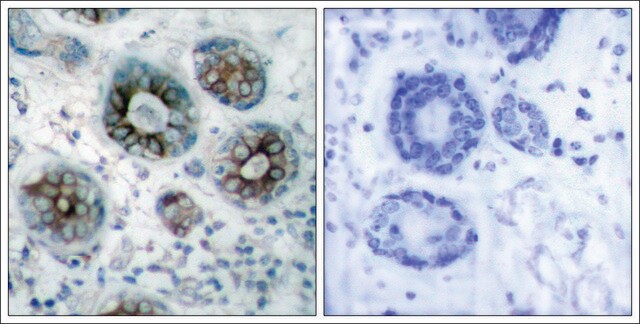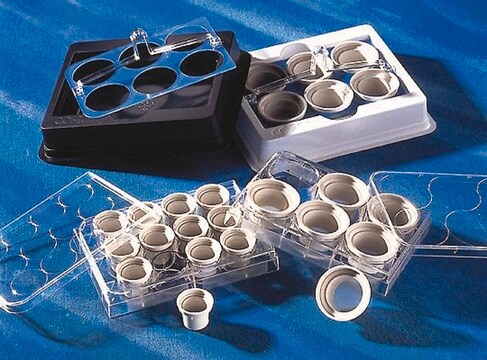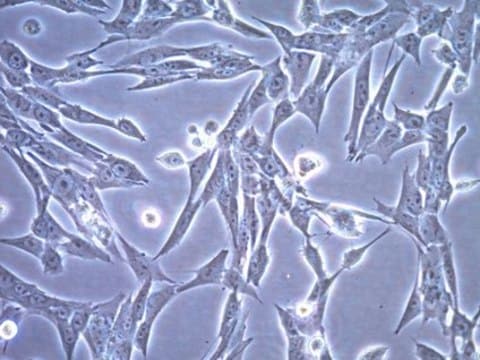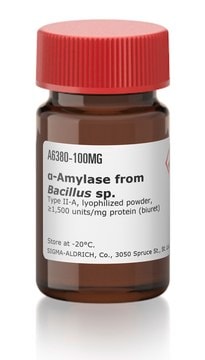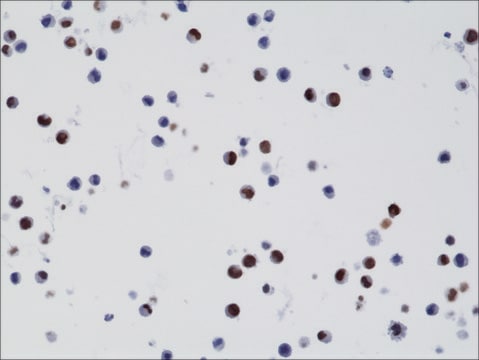SCC218
BCH869 Human H3K27M Glioma Cell lines
Se connecterpour consulter vos tarifs contractuels et ceux de votre entreprise/organisme
About This Item
Code UNSPSC :
41106514
Produits recommandés
Source biologique
human
Niveau de qualité
Conditionnement
vial of >1X10⁶ cells
Fabricant/nom de marque
Millipore
Mode de croissance
N/A
Technique(s)
cell culture | mammalian: suitable
Conditions d'expédition
liquid nitrogen
Température de stockage
−196°C
Application
- Each vial contains > 1X106 viable cells.
- Cells are tested negative for infectious diseases by a Human Essential CLEAR panel by Charles River Animal Diagnostic Services.
- Cells are verified to be of human origin and negative for inter-species contamination from mouse, rat, chinese hamster, Golden Syrian hamster, and Non-human Primate (NHP) as assessed by a Contamination Clear panel by Charles River Animal Diagnostic Services
- Cells are negative for mycoplasma contamination.
Pediatric high-grade glioma (pHGG) and diffuse intrinsic pontine glioma (DIPG) are among the most aggressive and recalcitrant cancers, with extremely low survival rates. Diffuse midline gliomas (DMG) with histone H3 lysine27-to-methionine mutations (H3K27M glioma) represent a highly aggressive subtype of glioma, which predominantly arise in children and young adults. The overall prognosis of H3K27M glioma is poor, displaying median survival rates of approximately 9 to 11 months.2 Aberrant activation of the PI3K pathway via PTEN silencing is a contributor to tumorigenesis in most pHG and DIP gliomas.
The BCH869 H3K27M glioma cell line is a representative model for H3K27M diffuse glioma. BCH869 cells grow as neurospheres and carry mutations in oncogenes ACVR1, PIK3CA, and PPM1D in addition to H3K27M mutation.3 BCH869 cells express EGFR, a common glioma marker, and have been validated via staining for the H3.3 K27M oncohistone mutant. BCH869 cell line has been used in the investigation of radiosensitization factors and tumorigenesis pathways, and is a highly clinically relevant model for this especially serious form of pediatric glioma.
Source
BCH869 cell line was derived from Pons tissue of a 7-year-old female patient.4
<bold>References</bold>
1. Neuro Oncol 2017, 19(2):153-161.
2. Front Oncol 2020, 9:1436.
3. Cancer Res 2018, 78(14): 4007-4021.
4. Suva et al. US Patent application pub. US 2020/0384022 A1
The BCH869 H3K27M glioma cell line is a representative model for H3K27M diffuse glioma. BCH869 cells grow as neurospheres and carry mutations in oncogenes ACVR1, PIK3CA, and PPM1D in addition to H3K27M mutation.3 BCH869 cells express EGFR, a common glioma marker, and have been validated via staining for the H3.3 K27M oncohistone mutant. BCH869 cell line has been used in the investigation of radiosensitization factors and tumorigenesis pathways, and is a highly clinically relevant model for this especially serious form of pediatric glioma.
Source
BCH869 cell line was derived from Pons tissue of a 7-year-old female patient.4
<bold>References</bold>
1. Neuro Oncol 2017, 19(2):153-161.
2. Front Oncol 2020, 9:1436.
3. Cancer Res 2018, 78(14): 4007-4021.
4. Suva et al. US Patent application pub. US 2020/0384022 A1
Caractéristiques et avantages
BCH869 cell line has been used in the investigation of radiosensitization factors and tumorigenesis pathways, and is a highly clinically relevant model for this especially serious form of pediatric glioma.
Stockage et stabilité
The cells should be stored in liquid nitrogen until use. The cells can be cultured for at least 10 passages after initial thawing without significantly affecting functionality.
Autres remarques
This product is intended for sale and sold solely to academic institutions for internal academic research use per the terms of the “Academic Use Agreement” as detailed in the product documentation.
Clause de non-responsabilité
RESEARCH USE ONLY. This product is regulated in France when intended to be used for scientific purposes, including for import and export activities (Article L 1211-1 paragraph 2 of the Public Health Code). The purchaser (i.e. enduser) is required to obtain an import authorization from the France Ministry of Research referred in the Article L1245-5-1 II. of Public Health Code. By ordering this product, you are confirming that you have obtained the proper import authorization.
Unless otherwise stated in our catalog or other company documentation accompanying the product(s), our products are intended for research use only and are not to be used for any other purpose, which includes but is not limited to, unauthorized commercial uses, in vitro diagnostic uses, ex vivo or in vivo therapeutic uses or any type of consumption or application to humans or animals.
Code de la classe de stockage
10 - Combustible liquids
Classe de danger pour l'eau (WGK)
WGK 2
Point d'éclair (°F)
Not applicable
Point d'éclair (°C)
Not applicable
Certificats d'analyse (COA)
Recherchez un Certificats d'analyse (COA) en saisissant le numéro de lot du produit. Les numéros de lot figurent sur l'étiquette du produit après les mots "Lot" ou "Batch".
Déjà en possession de ce produit ?
Retrouvez la documentation relative aux produits que vous avez récemment achetés dans la Bibliothèque de documents.
Notre équipe de scientifiques dispose d'une expérience dans tous les secteurs de la recherche, notamment en sciences de la vie, science des matériaux, synthèse chimique, chromatographie, analyse et dans de nombreux autres domaines..
Contacter notre Service technique

